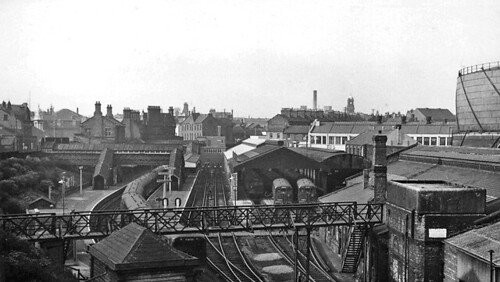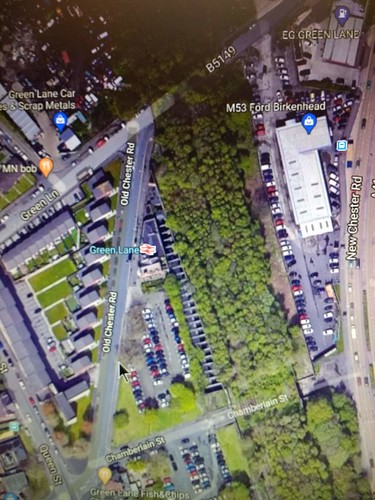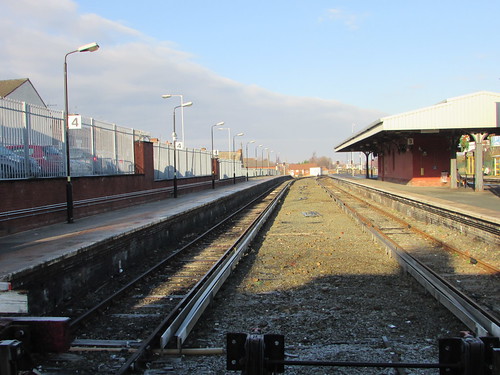Initially, there was only one station on the Liverpool side of the river, underground at James Street, accessed from street level by three large hydraulic lifts. From here, the railway line descended on a gradient of 1 in 27 under the river before climbing at a gradient of 1 in 30 to Birkenhead Hamilton Square station. Like James Street, this station was underground, accessed from street level by three large hydraulic lifts. The line continued south in a tunnel to the railway's headquarters at Birkenhead Central which was located in a cutting with retaining walls. The line extended south in cutting and tunnel to the final, sub-surface station at Green Lane.
At Shore Road, Birkenhead and Mann Island, Liverpool huge, steam-powered pumps were provided to keep the tunnel free of water.
At the time of the railway's opening, extensions to the line were already in hand. In 1888, the first to open was a branch in a tunnel from Birkenhead Hamilton Square to Birkenhead Park, to make an end-on connection with the relocated terminus of what became the Wirral Railway. This allowed through-running of Mersey Railway trains to and from locations on the Wirral, although locomotives were exchanged at Birkenhead Park. The extension from Green Park via cutting and tunnel to the surface station Rock Ferry and, on the Liverpool side, from James Street by tunnel (on a gradient varying between 1 in 31 and 1 in 34) to an underground station below the Liverpool Central station of the Cheshire Lines Committee were both opened in 1891.
Beyer Peacock supplied eight 0-6-4 and ten 2-6-2 condensing tank locomotives to operate the line.

Beyer Peacock 0-6-4 condensing tank for Mersey Railway (The Engineer)

Beyer Peacock 2-6-2 condensing tank for Mersey Railway (Railway Archive)
The condensing feature was used when travelling in tunnels. On arrival at Liverpool Central, a second locomotive was attached to the rear to form the departing train whilst the incoming engine uncoupled, 'dumped' the heated tank water, refilled with cold (conventional boiler feed injectors fail to operate reliably with hot water) and prepared to take out the next arrival.
Trains comprised eight 4-wheel passenger and one 4-wheel brake coach, each 27 feet in length.
With the extensions to the line in place, the railway offered good connections and a faster crossing than the ferries but using steam operation, conditions in the tunnels were foul, despite the massive fans provided, and revenue decreased, forcing the railway to continue operations in receivership.
Salvation came in 1903 in the form of an American, George Westinghouse, who was able to propose conversion to electric traction, using a fourth rail system operating at 650 volts d.c. Power was provided by three 1,650 h.p. generators driven by steam located in the pumping station at Shore Road, Birkenhead. Two, smaller 300 h.p. generators were also provided for lighting and other purposes.
Spacious bogie coaches to American design formed the replacement electric trains and these became popular with passengers, although no heating was provided. Air brakes were fitted but without compressors on the train, so periodically crews had to re-charge the train air receivers from an 'air main' at stations. All through-running at Birkenhead Park ceased.
At the railway 'Grouping', the Mersey Railway remained independent but the Wirral Railway became part of the L.M.S. empire. The Mersey Railway continued its role unchanged until 1938 when the L.M.S. electrified the Wirral lines (using the third-rail system). Running rights for the new L.M.S. electric multiple unit trains to operate to Liverpool Central and for the Mersey Railway electrics to serve the Wirral were established. The elderly Mersey Railway electrics required refurbishment to serve this extended role. Facilities to change between third-rail and fourth-rail current collection were provided, together with heaters and on-board electric compressors for the brake system.
Railway Nationalisation in 1948 finally brought an end to the Mersey Railway's independence and it became part of British Railways London Midland Region. But, repainted and renumbered, the Mersey Railway's electric trains carried on until 1956 when LMS-design electric multiple units started to replace the elderly vehicles. The last was withdrawn in 1957.
In 1977, the ambitious 'Liverpool Loop' scheme was opened by British Rail. This extended the line beyond Liverpool Central station so as to serve Liverpool Lime Street station by a reversing loop.
In recent years, I've looked at stations on the original Mersey Railway as part of a study of the modern Merseyrail system and there are notes below on three of those stations.
Birkenhead Central
The railway's headquarters at Birkenhead Central were fitted into a cramped location below ground level bounded by a cutting on one side and retaining walls abutting the gas works on the other. The station provided two through platforms, a south-facing bay, the 3-road steam locomotive shed and a carriage shed, as shown on the fragment of the 1912 Ordnance Survey map below. The right hand edge of the map shows the LNWR/GWR joint line which ran from Birkenhead (Woodside) to Chester (General). The large Engine Shed in the lower half is actually two engine sheds side-by-side for the LNWR and GWR.

Birkenhead Central station 1912: Birkenhead 25 inches to 1 mile map (National Library of Scotland)
The modern satellite view below shows what has survived. The platforms and station buildings are still there but the bay platform has become a siding. The carriage shed has been re-roofed and, in a different form, extended. The Mersey Railway steam locomotive shed has gone, as has the adjacent gas works (although some of my pictures from 2014 reveal abandoned steelwork which formed part of one of the access stairs to a rolling lift gasholder which I believe replaced the column-supported designs shown on the 1912 map). The large LNWR/GWR locomotive shed has gone and the area is overgrown.

Birkenhead Central station: satellite view (Google Maps)
Below, a few illustrations of Birkenhead Central over the years.

Birkenhead central in steam days, drawn by T. Raffles Davison (Mersey Railway)

Birkenhead Central, 1961 (Photo: Ben Brooksbank CC BY-SA2.0)

Merseyrail: Birkenhead Central in 2014, showing former carriage sidings.
Green Lane
The railway is below street level with a tunnel to the north leading towards Birkenhead Central and a short tunnel to the south, leading towards Rock Ferry. There are two platforms, set in a rectangular excavation with the retaining walls beautifully-executed stonework. A series of plate girders span the station and the spaces between these girders are partially infilled by brick arcading but only above the southbound track, giving the station a rather 'lopsided' appearance. I presume this was to support trackwork leading to the LNWR/GWR steam locomotive sheds serving the joint Line from Chester to Birkenhead Woodside which ran slightly to one side of Green Lane above ground level. Quite generous station buildings were provided at street level.

Birkenhead Green Lane station 1912: Birkenhead 25 inches to 1 mile map(National Library of Scotland)
The modern satellite view below shows that the railway is little changed. The multiple plate girders bridging the station are clearly visible. The whole of the area where the joint line once ran is abandoned andvery overgrown with vegetation. The station buildings with their wedge-shaped plan remain.

Green Lane station: satellite view (Google Maps)
Below, pictures illustrating changes at Green Lane over the years.

Green Lane station in steam days, looking north, drawn by T. Raffles Davison (Mersey Railway)

Green Lane station, Merseyrail in 2020, looking south, showing stonework, overhead plate girders, partially infilled by brick arcading, and short tunnel towards Rock Ferry.
Rock Ferry
The 1891 southwards extension of the Mersey Railway to the surface station at Rock Ferry offered platform-to-platform interchange with the through platforms on the LNWR/GWR Joint Line which ran from Birkenhead (Woodside) to Chester (General). Mersey Railway trains ran to two terminal platforms provided with a middle engine release siding. North of Rock Ferry Station, at Union Street, connections were provided between the Mersey Railway and the Joint Line but I believe these were originally not much used.

Rockferry station 1912: Birkenhead 25 inches to 1 mile map (National Library of Scotland)
The modern satellite view below shows the major changes to the railway. The two terminal platforms of the Mersey Railway survive but the engine release road is now removed. The four tracks of the Joint Line have gone, but the Mersey Railway route has been slewed to occupy the trackbed of the Western pair of Joint Lines. The trackbed of the Eastern pair of joint lines was retained for a time to provide connections to the Birkenhead Docks railway system, but these are out of use. The island platform serving one terminal platform and the northbound through platform is re-roofed but not much changed. The southbound through platform is modernised and the associated access footbridge is new.

Rockferry station: satellite view (Google Maps)

Rock Ferry station in 2016 - terminal platforms 4 and 3, looking north. There was originally a 'middle siding'.

Rock Ferry station in 2016, view looking north from footbridge.
Thomas Raffles Davison
The pencil sketches of Birkenhead North and Green Lane above are the work of Thomas Raffles Davison (1853-1937), a prolific architectural illustrator, journalist, editor and occasional architect. There's a Wikipedia article about him here.
Books
[1] ‘The Line Beneath The Liners: A hundred years of Mersey Railway sights and sounds’ by John W. Gahan, published by Countyvise (ISBN 0 907768 40 7 and Avon AngliA Publications (0 905466 57 8).
[2] ‘Chester to Birkenhead including the Helsby Branch’ by Vic Mitchell and Keith Smith (Middleton Press 2012) ISBN 978 1 908174 21 5.
Posts on this website referring to Merseyrail
Early Days of the Mersey Railway 8-Oct-2013.
Day Trip to Liverpool 24-May-2010.
By rail to Liverpool (Part 2) 24-Mar-2014.
Birkenhead and New Brighton by train (Part 1) 19-Feb-2014.
Birkenhead and New Brighton by train (Part 3) 24-Feb-2014.
Railways around Birkenhead 28-Feb-2014.
More Merseyrail 21-Oct-2014.
Return to Liverpool 19-Mar-2020.
Quite a few of my posts relate to Merseyside. Your can display all these posts, in reverse date-of-posting order, by selecting Label 'Merseyside' or click here).
My pictures on the Merseyrail network
Where necessary, clicking on an image above will display an 'uncropped' view or, alternately, pictures may be selected, viewed or downloaded, in various sizes, from the albums below:-
Albums showing stations discussed in this post:-
Birkenhead Central Station
Green Lane
Rock Ferry
Merseyrail.
Profile - 'Cecil Raikes' (The locomotive).
